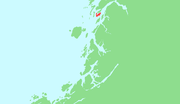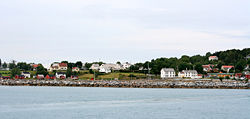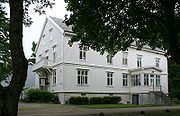
Tjøtta
Encyclopedia

Nordland
is a county in Norway in the North Norway region, bordering Troms in the north, Nord-Trøndelag in the south, Norrbottens län in Sweden to the east, Västerbottens län to the southeast, and the Atlantic Ocean to the west. The county was formerly known as Nordlandene amt. The county administration is...
county, Norway
Norway
Norway , officially the Kingdom of Norway, is a Nordic unitary constitutional monarchy whose territory comprises the western portion of the Scandinavian Peninsula, Jan Mayen, and the Arctic archipelago of Svalbard and Bouvet Island. Norway has a total area of and a population of about 4.9 million...
. It is now part of Alstahaug
Alstahaug
Alstahaug is a municipality in Nordland county, Norway. It is part of the Helgeland region. The administrative centre of the municipality is the town of Sandnessjøen....
municipality.


Location
The village Tjøtta is located on the southern tip of the island of the same name, which is located south of AlstenAlsten
Alsten is an island in Alstahaug municipality off the coast of Nordland county, Norway. The Seven Sisters mountain range and the town Sandnessjøen are situated on the island.Its area is 153 km². The highest point is Botnkrona, 1072 m....
.The municipality was created in 1862 by a split from Alstahaug
Alstahaug
Alstahaug is a municipality in Nordland county, Norway. It is part of the Helgeland region. The administrative centre of the municipality is the town of Sandnessjøen....
. At that time Tjøtta had a population of 2,781. On 1 July 1917 Vevelstad
Vevelstad
Vevelstad is a municipality in Nordland county, Norway. It is part of the Helgeland traditional region. The administrative centre of the municipality is the village of Forvika. -General information:...
was split from Tjøtta to constitute a municipality of its own, leaving Tjøtta with 2,287 inhabitants. On 1 July 1920 the farm Giskåen with 10 inhabitants was moved to Vevelstad.
On 1 January 1964 the district on the eastern part of Alsten, with a population of 180, was incorporated into Leirfjord
Leirfjord
Leirfjord is a municipality in Nordland county, Norway. It is part of the Helgeland traditional region. The administrative centre of the municipality is the village of Leland....
municipality. On 1 January 1965 the district Skogsholmen with 196 inhabitants was incorporated into Vega
Vega, Norway
Vega is a municipality in Nordland county, Norway. It is part of the Helgeland traditional region. The administrative centre of the municipality is the village of Gladstad. Other villages include Holand and Ylvingen....
whereas the rest of Tjøtta, with 1,477 inhabitants, was reunited with Alstahaug.
Tjøtta gard, the largest farm in North Norway, is located in Tjøtta. By North Norwegian standards, the climate is mild with a long summer suited for agriculture; monthly 24-hr averages range from -1.8°C in the coldest month to 13°C in both July and August; average yearly rainfall is 1,020 mm (Source:met.no 1961-90 ).
Tjøtta is mentioned in Heimskringla
Heimskringla
Heimskringla is the best known of the Old Norse kings' sagas. It was written in Old Norse in Iceland by the poet and historian Snorri Sturluson ca. 1230...
many times; this was the home of Hårek, one of the leaders of the peasant army which killed Olav Haraldsson at the Battle of Stiklestad
Battle of Stiklestad
The Battle of Stiklestad in 1030 is one of the most famous battles in the history of Norway. In this battle, King Olaf II of Norway was killed. He was later canonized...
. There is archeological evidence of Iron Age
Iron Age
The Iron Age is the archaeological period generally occurring after the Bronze Age, marked by the prevalent use of iron. The early period of the age is characterized by the widespread use of iron or steel. The adoption of such material coincided with other changes in society, including differing...
agriculture in the area.
Gullhaugen
Tjøtta is the location of Gullhaugen, from the Old NorseOld Norse
Old Norse is a North Germanic language that was spoken by inhabitants of Scandinavia and inhabitants of their overseas settlements during the Viking Age, until about 1300....
word haugr meaning hill or mound. Gullhaugen is the site of a large burial mound consisting of over 30 mounds, 5 large round mounds, several elongated mounds, 2 large burial cairns, several stone rings, and a large number of smaller round mounds. The largest mound is about 25 metres across and 2–3 metres high. All the mounds in this part of the cemetery has been dated back to the Iron Age.
Tjøtta International War Cemetery
The World War IIWorld War II
World War II, or the Second World War , was a global conflict lasting from 1939 to 1945, involving most of the world's nations—including all of the great powers—eventually forming two opposing military alliances: the Allies and the Axis...
international war cemetery
Cemetery
A cemetery is a place in which dead bodies and cremated remains are buried. The term "cemetery" implies that the land is specifically designated as a burying ground. Cemeteries in the Western world are where the final ceremonies of death are observed...
at Tjøtta has more than 7,500 war graves, mostly Russians
Russians
The Russian people are an East Slavic ethnic group native to Russia, speaking the Russian language and primarily living in Russia and neighboring countries....
who were taken prisoners by Nazi Germany
Nazi Germany
Nazi Germany , also known as the Third Reich , but officially called German Reich from 1933 to 1943 and Greater German Reich from 26 June 1943 onward, is the name commonly used to refer to the state of Germany from 1933 to 1945, when it was a totalitarian dictatorship ruled by...
. The Soviet prisoners of war who died in North Norway during World War II, were buried in ordinary cemeteries. After the war, however, the Norwegian authorities decided that they should be moved and brought together in a common cemetery on state ground in Tjøtta. The cemetery was consecrated in 1953 and comprises an enclosed common grave to the north with 6,725 dead, and 826 individual graves to the south.
The Rigel ship catastrophe, claiming some 2,500 lives off the island, also has a monument. The event is considered one of the most significant shipwrecks in the world. The wreck lay partially submerged off the coast of Rosøya island until about 1970, but has now been removed. This cemetery was consecrated in 1970. All the graves are anonymous, but a memorial stone in the form of a cross has been erected on the site. This memorial was devoted to all of those who perished at the sinking of the troop transport ship Rigel on November 27, 1944.

